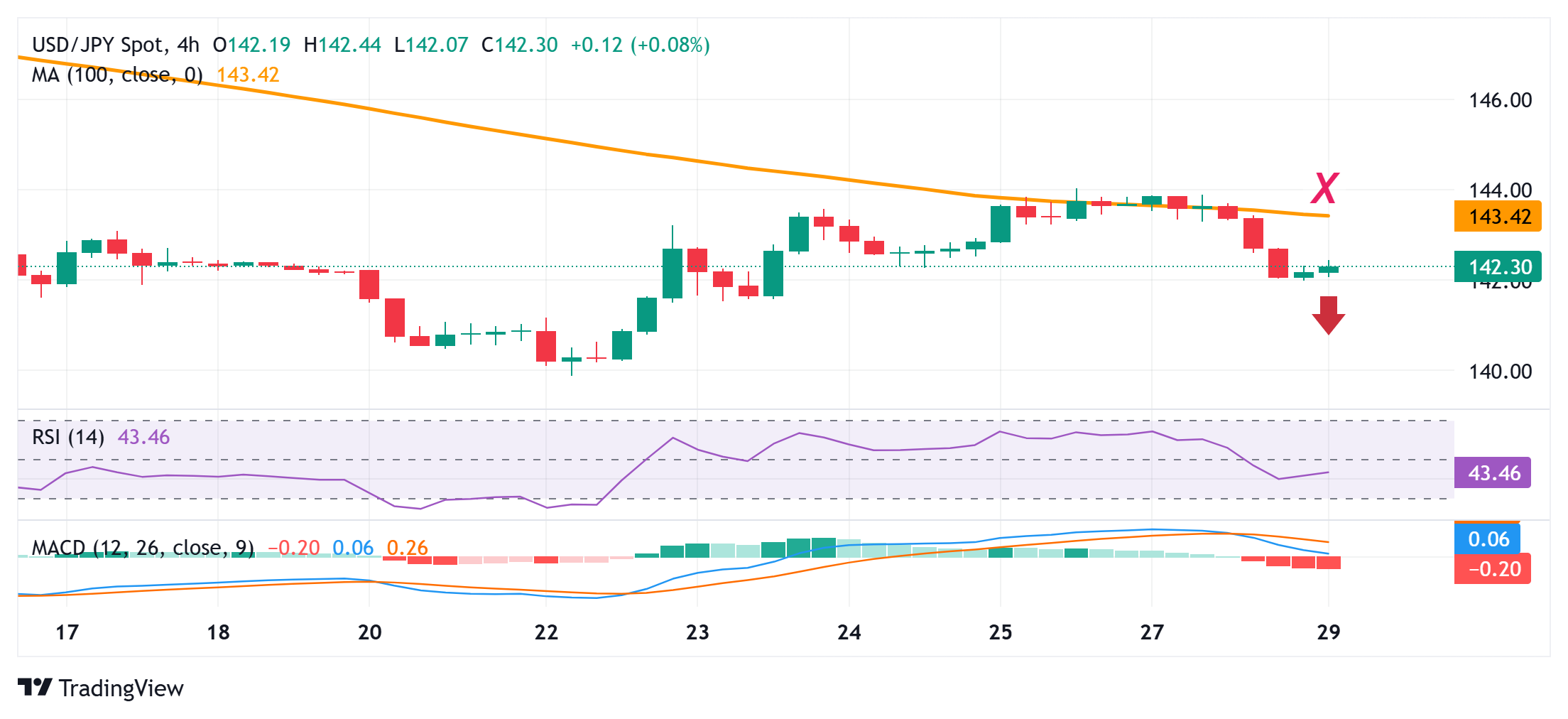- The Japanese Yen attracts some sellers as easing trade tensions undermines safe-haven demand.
- Hopes for a US-Japan trade deal and geopolitical risks should help limit any meaningful downfall.
- The divergent BoJ-Fed policy expectations should further lend support to the lower-yielding JPY.
The Japanese Yen (JPY) remains on the back foot through the Asian session on Tuesday as signs of easing tensions between the US and China undermine demand for traditional safe-haven assets. Apart from this, the emergence of some US Dollar (USD) dip-buying lifts the USD/JPY pair to a fresh daily high, close to mid-142.00s in the last hour. Any meaningful JPY depreciation, however, seems elusive as traders might opt to wait for the Bank of Japan (BoJ) policy meeting this week.
The Japanese central bank is scheduled to announce its decision on Thursday and is expected to keep interest rates steady amid risks to the fragile economy from US tariffs. However, signs of broadening inflation in Japan keep the door open for further tightening by the BoJ. Moreover, persistent geopolitical tensions and the uncertainty over US President Donald Trump’s trade policies keep investors on the edge, which, in turn, should help limit deeper losses for the safe-haven JPY.
Japanese Yen is undermined by receding safe-haven demand
- US Treasury Secretary Scott Bessent said on Monday that many countries have offered ’very good’ tariff proposals. This comes on top of optimism over the potential de-escalation of trade tensions between the US and China and remains supportive of a positive risk tone.
- However, mixed signals regarding the state of negotiations from the US and China add a layer of uncertainty. In fact, US President Donald Trump said last week that trade talks with China were underway, though China has denied that any tariff negotiations were taking place.
- The Bank of Japan is expected to move cautiously and pause further rate hikes amid concerns that the new US tariffs could shave off 0.5% of Japan’s GDP. That said, higher inflation and bumper pay rise provide the BoJ headroom for further monetary policy normalization this year.
- Furthermore, a quick trade agreement between the US and Japan could give the BoJ more confidence to hike rates again. This marks a big divergence in comparison to the growing acceptance that slowing global growth will encourage the Federal Reserve to deliver deeper rate cuts.
- Traders are pricing in the possibility that the US central bank will resume its rate-cutting cycle in June and lower borrowing costs by a full percentage point by the end of 2025. The resultant narrowing of the US-Japan rate differential should underpin the lower-yielding Japanese Yen.
- Russian President Vladimir Putin declared a surprise 72-hour unilateral ceasefire in the Ukraine conflict from May 8, though Ukraine’s President Volodymyr Zelensky dismissed the three-day truce. This keeps the geopolitical risk premium in play and could further benefit the safe-haven JPY.
- The US Dollar struggles to capitalize on last week’s recovery from a multi-year low, as skepticism over Trump’s trade policies and caution ahead of the BoJ meeting and US data cap USD/JPY upside.
- Investors will scrutinize the BoJ’s updated economic projections for cues about the timeline for the next rate hike. Meanwhile, the US JOLTS job openings on Tuesday, US Personal Consumption Expenditures on Wednesday, and the Nonfarm Payrolls (NFP) on Friday might provide insight into the Fed’s policy outlook.
USD/JPY bears have the upper hand while below the 144.00 pivotal resistance

From a technical perspective, the USD/JPY pair struggled to find acceptance above the 100-period Simple Moving Average (SMA) on the 4-hour chart and faced rejection near the 144.00 mark. Given that oscillators are holding in negative territory on daily and hourly charts, some follow-through selling below the 142.00 round figure will be seen as a fresh trigger for bearish traders. Spot prices might then accelerate the fall towards the mid-141.00s en route to the 141.10-141.00 region. The downward trajectory could extend further towards intermediate support near the 140.50 area and eventually expose the multi-month low – levels below the 140.00 psychological mark touched last week.
On the flip side, the immediate hurdle is pegged near the 142.60-142.65 region, above which a bout of a short-covering could lift the USD/JPY pair to the 143.00 mark en route to the next relevant resistance near the 143.40-143.45 zone. Some follow-through buying should allow spot prices to conquer the 144.00 round figure. A sustained strength and acceptance above the latter would suggest that the pair has formed a near-term bottom and pave the way for some meaningful upside.
Risk sentiment FAQs
In the world of financial jargon the two widely used terms “risk-on” and “risk off” refer to the level of risk that investors are willing to stomach during the period referenced. In a “risk-on” market, investors are optimistic about the future and more willing to buy risky assets. In a “risk-off” market investors start to ‘play it safe’ because they are worried about the future, and therefore buy less risky assets that are more certain of bringing a return, even if it is relatively modest.
Typically, during periods of “risk-on”, stock markets will rise, most commodities – except Gold – will also gain in value, since they benefit from a positive growth outlook. The currencies of nations that are heavy commodity exporters strengthen because of increased demand, and Cryptocurrencies rise. In a “risk-off” market, Bonds go up – especially major government Bonds – Gold shines, and safe-haven currencies such as the Japanese Yen, Swiss Franc and US Dollar all benefit.
The Australian Dollar (AUD), the Canadian Dollar (CAD), the New Zealand Dollar (NZD) and minor FX like the Ruble (RUB) and the South African Rand (ZAR), all tend to rise in markets that are “risk-on”. This is because the economies of these currencies are heavily reliant on commodity exports for growth, and commodities tend to rise in price during risk-on periods. This is because investors foresee greater demand for raw materials in the future due to heightened economic activity.
The major currencies that tend to rise during periods of “risk-off” are the US Dollar (USD), the Japanese Yen (JPY) and the Swiss Franc (CHF). The US Dollar, because it is the world’s reserve currency, and because in times of crisis investors buy US government debt, which is seen as safe because the largest economy in the world is unlikely to default. The Yen, from increased demand for Japanese government bonds, because a high proportion are held by domestic investors who are unlikely to dump them – even in a crisis. The Swiss Franc, because strict Swiss banking laws offer investors enhanced capital protection.

